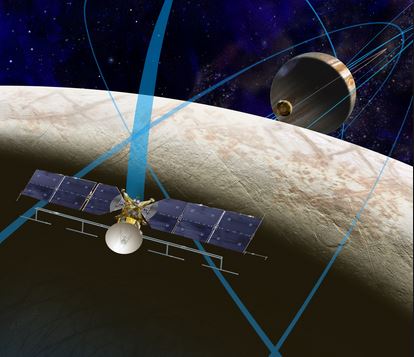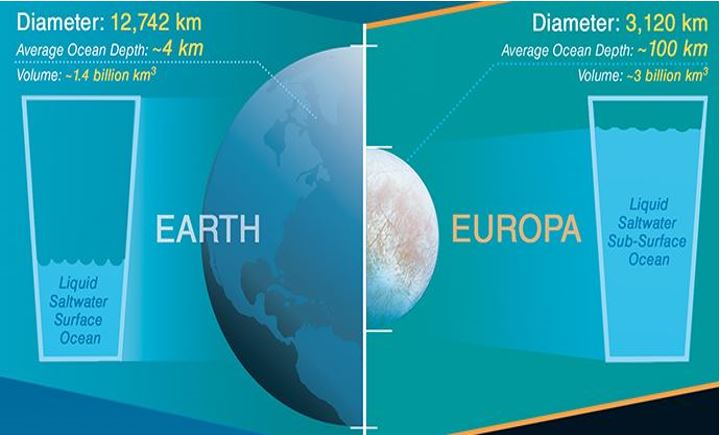The White House has proposed NASA receives $18.5 billion in 2016, which includes $30 million towards a mission to determine whether there is life in Europa’s vast ocean below its icy surface.
Europa, one of the moons that orbits Jupiter, is primarily made of silicate rock. It has a water-ice crust and an iron-nickel core. Scientists believe it has an oxygen-rich atmosphere.
Astronomers are convinced Europa has a huge ocean below its icy crust. Vapor plumes have been detected venting from its south pole.
NASA’s Jet Propulsion Laboratory (JPL) has a concept under study – The Europa Clipper – that would conduct detailed reconnaissance of Europa and would investigate whether the icy moon might harbor conditions suitable for life.

While orbiting Jupiter, the spacecraft would carry out several Europa flybys. (Image: NASA’s JPL)
The aim is to place a spacecraft in orbit around Jupiter in order to perform a detailed investigation of Europa “A world that shows strong evidence for an ocean of liquid water beneath its icy crust and which could host conditions favorable for life.”
“The mission would send a highly capable, radiation-tolerant spacecraft into a long, looping orbit around Jupiter to perform repeated close flybys of Europa,” says JPL.
The JPL says the spacecraft would have radar to penetrate the frozen crust and determine how thick the ice shell is, an infrared spectrometer to investigate the composition of the moon’s surface materials, an ion and neutral mass spectrometer to analyze Europa’s trace atmosphere during flybys, and a topographic camera for high-resolution imaging of surface features.
The plan is for the Europa Clipper mission to perform 45 Europa flybys at altitudes ranging from 1,700 to 16 miles (2,700 to 25 km).

Where there is water and oxygen, there could be life. Between 50% and 80% of all life on Earth is in our oceans, including mammals, mollusks, fish, algae, reefs, reptiles, fungi, bacteria and plants. (Image: NASA)
There is also talk of placing a lander on Europa’s surface ice.
NASA administrator Charles Bolden said:
“Looking to the future, we’re planning a mission to explore Jupiter’s fascinating moon Europa, selecting instruments this spring and moving toward the next phase of our work.”
Previously, $100 million had been committed to the project, which is a tiny sum compared to the $2.5 billion spent on the Mars Curiosity rover. However, a total of $2 billion is likely to be spent over the next few years.
The mission is expected to occur in the early 2020s.
NASA Video – Reach for New Heights
